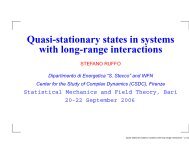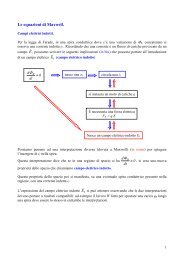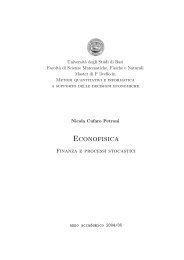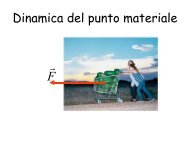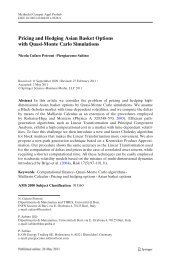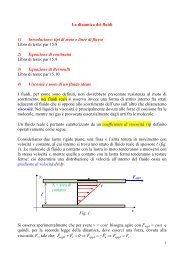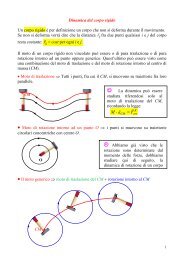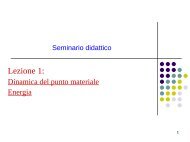String Theory and Pre-big bang Cosmology - Infn
String Theory and Pre-big bang Cosmology - Infn
String Theory and Pre-big bang Cosmology - Infn
Create successful ePaper yourself
Turn your PDF publications into a flip-book with our unique Google optimized e-Paper software.
<strong>String</strong> theory <strong>and</strong> pre-<strong>big</strong> <strong>bang</strong> cosmologyM. Gasperini 1 <strong>and</strong> G. Veneziano 21 Dipartimento di Fisica , Università di Bari, Via G. Amendola 173, 70126 Bari,Italy, <strong>and</strong> Istituto Nazionale di Fisica Nucleare, Sezione di Bari, Bari, Italy,gasperini@ba.infn.it2 CERN, <strong>Theory</strong> Unit, Physics Department, CH-1211 Geneva 23, Switzerl<strong>and</strong>,<strong>and</strong> College de France, 11 Place M. Berthelot, 75005 Paris, France,gabriele.veneziano@cern.chSummary. In string theory, the traditional picture of a Universe that emerges fromthe inflation of a very small <strong>and</strong> highly curved space-time patch is a possibility, not anecessity: quite different initial conditions are possible, <strong>and</strong> not necessarily unlikely.In particular, the duality symmetries of string theory suggest scenarios in which theUniverse starts inflating from an initial state characterized by very small curvature<strong>and</strong> interactions. Such a state, being gravitationally unstable, will evolve towardshigher curvature <strong>and</strong> coupling, until string-size effects <strong>and</strong> loop corrections make theUniverse “bounce” into a st<strong>and</strong>ard, decreasing-curvature regime. In such a context,the hot <strong>big</strong> <strong>bang</strong> of conventional cosmology is replaced by a “hot <strong>big</strong> bounce” inwhich the bouncing <strong>and</strong> heating mechanisms originate from the quantum productionof particles in the high-curvature, large-coupling pre-bounce phase. Thanks to thestrong coupling there is also an associate production of higher-dimensional branes,which could prepare (<strong>and</strong> provide the initial conditions for) a subsequent phase ofbrane-dominated inflation.1 IntroductionThe st<strong>and</strong>ard cosmological model, formulated <strong>and</strong> brought to completion byvarious authors during the second half of the last century (see for instance [1,2]), provides us with an excellent description of the various important stages ofour past cosmological history (such as the radiation era, the nucleosynthesis,the recombination era, the epoch of matter domination, . . . ). At early enoughtimes, however, such a model is to be modified by the introduction of a “nonst<strong>and</strong>ard”epoch of accelerated cosmic evolution, called “inflation”, whichis needed in order to solve the horizon, flatness <strong>and</strong> entropy problems [3]implied by the extrapolation, back in time, of the present state according tothe st<strong>and</strong>ard cosmological equations.The introduction of a sufficiently long inflationary phase not only “explains”the otherwise unnatural initial conditions required by the subsequent
<strong>Pre</strong>-<strong>big</strong> <strong>bang</strong> cosmology 7Looking at the subset of massless eigenstates, in fact, we find that theopen string spectrum contains (even in the simplest case) a vector A µ whichis transverse (i.e., it has a vanishing divergence, ∂ µ A µ = 0), <strong>and</strong> which can beassociated with an Abelian interaction of vector type, like the electromagneticinteraction. The closed string spectrum, instead, contains – besides a scalarφ, the dilaton, <strong>and</strong> a second-rank antisymmetric tensor B µν , – a symmetrictensor field h µν which is transverse <strong>and</strong> traceless (∂ ν h µν = 0 = h µ µ ), <strong>and</strong>which has all the required physical properties of the graviton. Thus, unifiedmodels of fundamental interactions based on strings must necessarily includea tensor interaction of gravitational type.2.2 SupersymmetryBut the virtues of string theory as basis for a unified model of all interactionsare not limited to this result. We should recall, indeed, that the spectrum ofthe bosonic string that we have considered contains, even after the eliminationof the ghost states, other states of “tachyonic” type (i.e., with M 2 < 0).To avoid such states (sources of instabilities in a quantum theory context)the model of bosonic string has to be “supersymmetrized”. The st<strong>and</strong>ardprocedure is to associate to the coordinates X µ , determining the position ofthe string in the external “target” space in which the string is embedded,the fermionic partners ψ µ , transforming as two-component Majorana spinorson the (two-dimensional) world-sheet spanned by the string motion, <strong>and</strong> asLorentz vectors (with index µ) in the target space manifold. This leads us tothe so-called superstring models, which can be consistently formulated (froma quantum point of view) only in five different versions [17, 18].This generalization of the string model not only eliminates tachyons fromthe physical spectrum – in a supersymmetric theory, the lowest allowed energylevel corresponds to M 2 = 0, <strong>and</strong> negative values are forbidden – butalso automatically introduces in the model the spinor fields required to describethe fundamental matter fields (quarks <strong>and</strong> leptons). In addition, if weconsider a model with open <strong>and</strong> closed superstrings, or a model of heteroticsuperstrings (i.e., closed strings in which only right-moving modes are supersymmetrized,while left-moving modes are not), we can directly includeinto the quantum spectrum also non-Abelian gauge fields, with gauge groupSO(32) or E 8 × E 8 [17, 18]. These superstring models, when quantized in aflat space-time manifold, are only consistent for a critical number D = 10 ofdimensions. Remarkably, when D − 4 = 6 spatial dimensions are appropriatelycompactified, the above gauge groups could possibly contain a realistic(low-energy) st<strong>and</strong>ard-model phenomenology.2.3 Conformal invarianceBut the most impressive aspect of string theory, for a physicist used to workwith the st<strong>and</strong>ard (classical or quantum) field theory, is probably the ability
<strong>Pre</strong>-<strong>big</strong> <strong>bang</strong> cosmology 9sible in a string theory context are those satisfying the conditions of conformalinvariance. Such conditions are represented by a set of differential equationscorresponding, in every respect, to the equations of motion of the field we areconsidering.Unfortunately, however, such equations can hardly be derived in closed<strong>and</strong> exact form for any given model of interacting string. In practice, wehave to adopt a perturbative approach: the action of the string interactingwith the background fields (also called “sigma model” action) is quantized byexp<strong>and</strong>ing in loops the quantum corrections (as in the st<strong>and</strong>ard field-theorycontext, but with the difference that we are dealing with a two-dimensionalconformal field theory). The absence of conformal anomalies is then imposedat any order of the loop expansion, determining the corresponding differentialconditions. As a result, the exact background field equations are approximatedby an infinite series of equations, containing higher <strong>and</strong> higher derivative termsas we consider loops of higher <strong>and</strong> higher order.To lowest order we then recover the second-order differential equationsalready well known for the classical fields (the Maxwell, Einstein, Yang-Millsequations, but also the Dirac equations for the fermion fields). To higherorders there are quantum corrections to these equations, in the form of higherderivatives of the fields, appearing as an expansion in powers of the parameterλ 2 s. The corrections to the equations of motion of order λ 2 s <strong>and</strong> higher are atypical effect of the theory due to the finite extension of strings: indeed, suchcorrections disappear in the point-particle limit λ s → 0, while they becomeimportant in the strong field/higher curvature limit in which the length scaleof a typical process (for instance, the space-time curvature scale) becomescomparable with the string scale λ s . In the context of pre-<strong>big</strong> <strong>bang</strong> cosmologysuch corrections can play an important role in the transition to the phase ofst<strong>and</strong>ard decelerated evolution, as we shall see in Sect. 4.2.4 Gravitational <strong>and</strong> cosmological applicationsLet us now come back to one of the main application of string theory ina gravitational context, concerning the problem of spacetime singularities.Unfortunately, technical difficulties have prevented, so far, to reach clear-cutconclusions on the fate of the cosmological singularity (unlike other kinds ofsingularities). By contrast, considerable progress was made on quantum blackhole physics, in particular a microscopic (statistical mechanics) underst<strong>and</strong>ingof their Bekenstein-Hawking entropy was achieved for a particular class ofblack holes [19]. Also, the study of (gedanken) superplanckian string collisions[20] has led to the conclusion that, in string theory, black holes have a minimalsize corresponding to a maximal Hawking temperature of the order of stringtheory’s maximal temperature [21, 22]. An obvious interpretation of this resultstems from the simple observation that fundamental quantum strings, unliketheir classical analogs, have a minimal optimal size, λ s . This physical argumentstrongly suggests a cosmological analogue of the above conclusion. Because of
10 M. Gasperini <strong>and</strong> G. Venezianotheir finite size quantum strings cannot occupy a vanishing volume, suggestingan upper limit to the energy density <strong>and</strong> the spacetime curvature. If so, stringtheory should be able to avoid – or reinterpret – the <strong>big</strong> <strong>bang</strong> singularitypredicted by classical general relativity.Other properties of quantum strings that could play an important role ina cosmological context are:1) Some new symmetries characterizing string theory as opposed to (classicalor quantum) field theory.2) The necessity of new dimensions of space.3) The existence of new light fields, at least within perturbation theory.Let us comment briefly on each one of them in turn.1. An example of a genuine stringy symmetry is the so-called target-spaceduality (or T-duality) [23]. It stems from quantum mechanics since it is due tothe possibility of interchanging the “winding” modes of a closed string (windingnumber being classically an integer, counting the number of times a stringis wrapped around a compact spatial dimension) with its momentum modes(which in a compact direction are discrete, thanks to quantum mechanics). Acosmological variant of T-duality is heavily used to motivate an example ofpre-<strong>big</strong> <strong>bang</strong> cosmology, as we shall see in Sect. 4.2. If we wish our string theory to allow for smooth, Minkowski-like solutions,we have to allow for more than three dimensions of space. At weakcoupling six extra dimensions are needed, while at strong coupling the dilatonfield (that controls the coupling) can be reinterpreted as a seventh extra dimensionof space (for a total of D = 11 spacetime dimensions). Although onewould like to have all the extra dimensions to be small <strong>and</strong> static during therecent history of our Universe, it is all but inconceivable that extra dimensionsmay have played some role in the very early (e.g. pre-<strong>big</strong> <strong>bang</strong>) Universe. Anexample of making good use of them in order to produce a realistic spectrumof density perturbations will be given in Sect. 43. <strong>String</strong> theory does not automatically give general relativity at largescales. Besides the presence of the extra dimensions, string theory also contains,at least in perturbation theory (i.e. at weak coupling), many masslessscalar particles in the spectrum that may induce unobserved long range forcesof gravitational (or even stronger) strength. These particles, <strong>and</strong> their interactions,are described by the low-energy string effective action which, as alreadystressed, controls the predictive power of the theory at the experimentally accessibleenergy scales (at least if the string <strong>and</strong> Planck scale are of comparablemagnitude).One of these particles is the above-mentioned dilaton. Its massless naturereflects the fact that, in perturbation theory, the so-called string couplingg s is a free parameter (see below for a short explanation of the connectionbetween the string coupling <strong>and</strong> the dilaton). Other (perturbatively) masslessparticles are those controlling the sizes <strong>and</strong> shapes of the extra dimensions.All these unwanted massless particles are generically called “moduli”, <strong>and</strong> the
<strong>Pre</strong>-<strong>big</strong> <strong>bang</strong> cosmology 11problem associated with them is called the “moduli stabilization problem”. Itis generally felt that the mechanism of spontaneous supersymmetry breaking,when correctly implemented, will produce a non-perturbative mass for themoduli <strong>and</strong> thus stabilize their value. If, however, as suggested by T-duality,the universe started at very weak coupling, the moduli may have been all butstatic in the early Universe, <strong>and</strong> may have affected its evolution in an essentialway. Consequences of such an evolution should be observable even today, aswe shall discuss in Sect. 4.2.5 Topological expansionIt seems finally appropriate, also in view of the subsequent cosmological applications,to explain the close connection between the string coupling parameterg s <strong>and</strong> the dilaton. Let us recall, to this purpose, that the higher-derivativeexpansion in powers of λ 2 s , introduced previously, is not the only perturbativeapproximation conceivable in a string theory context. Another (very useful)expansion of the equations of motion of the background fields concerns thetopology of the two-dimensional world-sheet surface spanned by the string: itis the so-called “higher genus” expansion.Consider for instance a closed string, whose propagation in the targetspacemanifold describes a cylindrical world-sheet surface. If the string splitsinto two strings, which subsequently recombine to form again the initial string(with a process analogous to the one described by a one-loop Feynman graphin quantum field theory), the world-sheet will acquire the topology of a torus(see Fig. 1). A process with n loops will correspond, in general, to a twodimensionalRiemann surface of genus n, i.e. to a manifold with n “h<strong>and</strong>les”.The interactions among strings can then be described, within a perturbativeapproach, by a partition function which can be exp<strong>and</strong>ed in world-sheetconfigurations of higher <strong>and</strong> higher genus.Fig. 1. One-loop graph for a point particle (left) <strong>and</strong> a closed string (right). Inthe left picture the world-line of a physical point particles (solid curve) splits intoa “world-loop” (dashed curve) representing a virtual particle-antiparticle pair generatedby the quantum fluctuations of the vacuum. In the right picture, where theworld-lines are replaced by cylindrical “world-sheet” surfaces, the same process isillustrated for the case of a closed string.For a two-dimensional, closed <strong>and</strong> orientable manifold, on the other h<strong>and</strong>,the genus n is determined by the so-called Euler characteristic χ = 2 − 2n.
<strong>Pre</strong>-<strong>big</strong> <strong>bang</strong> cosmology 13model of slow-roll inflation, as shown by various studies at the beginning ofthe Nineties [24, 25]. We are thus left with two possible alternatives:i) look for an inflationary scenario based on the dilaton, different from theconventional slow-roll inflation; orii) look for another mechanism, independent of the dilaton, <strong>and</strong> able to implementa phase of slow-roll inflation with some other typical ingredientof string theory.The first approach (also the first to be investigated, from a historical pointof view) has lead to the pre-<strong>big</strong> <strong>bang</strong> scenario that we shall present in the followingsection. The second approach, which only recently seems to have shownpositive results, has lead to scenarios where the inflaton field correspondsto the distance between two three-dimensional membranes (called 3-branes),propagating through a higher-dimensional space-time manifold.This section is devoted to a brief illustration of this second possibility,considering in particular the interaction between a brane <strong>and</strong> an anti-brane,which attract each other because of their opposite “charges” [26] (see [27] for adetailed introduction). It should be mentioned, however, that other examplesof brane-cosmology exist, in which the two 3-branes are “domain walls” representingthe space-time boundaries: we are referring to the so-called “ekpyrotic”[28, 29] or “new ekpyrotic” [30] scenario, where the brane interaction(<strong>and</strong> their eventual collision) is associated to the shrinking of an extra spatialdimension orthogonal to the branes. For that scenario we refer to the presentationof Paul Steinhardt <strong>and</strong> Neil Turok in this volume. One should alsomention the so-called models of “multi-brane” inflation [31], where severalM-theory branes combine their steep interactions to produce an acceptable(i.e., flat enough) inflaton potential as in models of “assisted” inflation [32].3.2 Dirichlet branesWe should explain, first of all, why higher-dimensional extended objects likebranes naturally (<strong>and</strong> unavoidably, in some cases) appear in the context ofstrings <strong>and</strong> superstring models. We recall, to this purpose, that there are twotypes of strings (open <strong>and</strong> closed), <strong>and</strong> that when studying the propagationof an open string in a (higher-dimensional) space-time manifold we have tospecify what happens to the ends of the string, imposing appropriate boundaryconditions [17, 18]. There are two types of such conditions.• Neumann boundary conditions, in which the ends of the string move insuch a way that there is no momentum flowing through the boundaries;• Dirichlet boundary conditions, in which the ends of the string are keptfixed.In particular, if the string is propagating through a background manifoldwith D spacetime dimensions, then the position of the ends of the string,with coordinates X µ 1 <strong>and</strong> Xµ 2 , with µ = 0, 1, . . ., D − 1, can be determined
14 M. Gasperini <strong>and</strong> G. Venezianoso as to satisfy Neumann conditions along p + 1 space-time dimensions, <strong>and</strong>Dirichlet conditions along the remaining (D − p − 1) (spacelike) orthogonaldirections. In this way the ends of an open string are localized on two p-dimensional hyperplanes at fixed positions X1 i, Xi 2 , with i ∈ [p + 1, D − 1] (thetwo hyperplanes can also be coincident, i.e. X1 i = X2). i Such p-dimensionalhyperplanes are called p-dimensional Dirichlet membranes, or D p -branes.It is important to stress that the ends of the open string are fixed alongthe Dirichlet directions, but can move freely along the (orthogonal) p + 1Neumann directions, spanning the “world-hypervolume” of the brane. Thestring ends, on the other h<strong>and</strong>, can bring charges, sources of non-Abelian gaugefields: this gives us a natural implementation of the so-called ”braneworld”scenario [33], in which the fundamental gauge interactions are strictly localizedon a (p + 1)-dimensional hypersurface which is only a “slice” of the higherdimensional“bulk” manifold in which the D p -brane is embedded. A D 3 -brane,in particular, could represent a simple model of our four-dimensional Universe,able to explain the “invisibility” – i.e. the inaccessibility through fundamentalgauge interactions – of the extra (D −4) spatial dimensions. Such dimensionsare necessarily required by a consistent theory of quantum strings, but cannotbe probed by interactions confined to live in four dimensions.In the context of superstring models, on the other h<strong>and</strong>, an extended objectlike a D p -brane acts as a source of a totally antisymmetric tensor field, just as apoint-like object (for instance, an electric charge) is a source for the vector fieldA µ in the conventional electromagnetic theory. The field A µ (represented by a1-form in the language of differential exterior forms) is coupled in fact to theworld-line X µ (ξ 0 ) spanned by the point-like source, with an interaction proportionalto Ẋµ A µ , where Ẋ = ∂X/∂ξ0 . In the same way, a one-dimensionalobject is a source for an antisymmetric field (or 2-form) A µν = −A νµ , which iscoupled to the two-dimensional “world-sheet” X µ (ξ 0 , ξ1) spanned by its evolution:the interaction is proportional to ɛ ab ∂ a X µ ∂ b X ν A µν , where ∂ ≡ ∂/∂ξ a ,a = 0, 1, <strong>and</strong> ɛ ab is the Levi-Civita antisymmetric symbol in two spacetimedimensions. In general, the (p + 1)-dimensional hypersurface X µ (ξ a ),a = 0, . . . , p, spanned by the time-evolution of a D p -brane, is coupled to a(p + 1)-form (i.e. to an antisymmetric tensor A µνα··· of rank p + 1), withinteractionɛ abc··· (∂ a X µ ∂ b X ν ∂ c X α · · ·)A µνα··· . (2)Thanks to these couplings, extended objects like D p -branes can interactamong themselves not only gravitationally, but also through the field A µνα···.D 3 -branes, in particular, interact with the four-form A µναβ present in thelow-energy spectrum of the type IIB superstring model [17, 18]. Such an interaction,as in the case of point-like electromagnetic sources, is repulsive forsources of the same sign (for instance, two identical particles or two identicalbranes), <strong>and</strong> attractive for sources of opposite sign (for instance, a particleantiparticlesystem, or a brane-antibrane system). In particular, for a systemof two identical, static, parallel <strong>and</strong> supersymmetric branes, initially arranged
<strong>Pre</strong>-<strong>big</strong> <strong>bang</strong> cosmology 174 The pre-<strong>big</strong> <strong>bang</strong> scenarioIf we look at the “specialized” literature for a description of the birth <strong>and</strong> ofthe first moments of life of our Universe, we may read, in the (probably) mostancient <strong>and</strong> authoritative book, that“In the beginning God created the Heaven <strong>and</strong> the Earth,<strong>and</strong> the Earth was without form, <strong>and</strong> void;<strong>and</strong> the darkness was upon the face of the deep.And the Breath of Godmoved upon the face of the water.”(Genesis, The Holy Bible).The most impressive aspect of these verses, for a modern cosmologist, is probablythe total absence of any reference to the hot, kinetic, explosive state thatone could expect at (or immediately after) the “<strong>big</strong> <strong>bang</strong>” deflagration. Whatis described, instead, is a somewhat quiet, dark, empty state: indeed, we canread about “void”, “darkness”, <strong>and</strong> “the deep” gives us the idea of somethingenormously desert <strong>and</strong> empty. In this static configuration there is at mostsome small fluctuation (the “Breath”, inducing a ripple on the surface of thisvacuum).It is amusing to note that a state of this type, flat, cold <strong>and</strong> vacuum,only ruffled by quantum fluctuations, can be obtained as the initial state ofour Universe in a string cosmology context, under the hypothesis that theUniverse evolves in a “self-dual” way with respect to a particular symmetryof the low-energy string effective action [15, 16].4.1 Scale-factor dualityThe symmetry we have in mind is the so-called scale-factor duality [16, 37],which generalizes to time-dependent backgrounds the T-duality symmetrymentioned in Sect. 2, typical of closed strings in static manifolds with compactspatial dimensions [23]. According to the T-duality symmetry the energyspectrum of a string, quantized in the presence of compact dimensionsof radius R, turns out to be invariant with respect to the transformationR → λ 2 s /R, <strong>and</strong> the simultaneous exchange of the number of times the stringis wounded around the compact dimensions with the (discrete) level-numberof the momentum operator associated with the string motion along such compactdirections.In the context of a homogenous, isotropic, spatially flat background, describedby the invariant space-time intervalds 2 = c 2 dt 2 − a 2 (t)dx i dx i , (3)the radius R is replaced by the scale factor a(t), <strong>and</strong> the invariance under thetransformation a → a −1 is still valid provided the dilaton field φ is also simultaneouslytransformed, according to the (scale-factor duality) transformation
<strong>Pre</strong>-<strong>big</strong> <strong>bang</strong> cosmology 19ρ → ˜ρ = ρ a 6 , p → ˜p = −p a 6 . (7)Thanks to this symmetry we can always associate to any decelerated solution,typical of the st<strong>and</strong>ard cosmological model, a “dual partner” describing accelerated(i.e. inflationary) evolution. We stress that this is impossible in thecontext of the cosmological Einstein equations, where there is no dilaton, <strong>and</strong>no duality symmetry.Consider, for instance, a radiation-dominated Universe, characterized bythe equation of state p = ρ/3, <strong>and</strong> by a constant dilaton, ˙φ = 0. In this casethe set of Eqs. (5) is identically satisfied by the particular exact solution( ) 1/2 ta = , φ = const, ρ = ρ 0t 0 a 4 , p = ρ , t > 0, (8)3where t 0 <strong>and</strong> ρ 0 are positive integration constants. This is also the exact solutionof the conventional Einstein equations which, for t > 0, properly describesthe radiation-dominated phase of the st<strong>and</strong>ard cosmological scenario [1]. Thissolution describes a phase of decelerated expansion, decreasing curvature <strong>and</strong>constant dilaton for 0 < t ≤ ∞,ȧ > 0, ä < 0, Ḣ < 0, ˙φ = 0, (9)namely a Universe evolving from the past <strong>big</strong> <strong>bang</strong> singularity (approachedas t → 0 from positive values) towards a state asymptotically flat <strong>and</strong> empty,approached as t → +∞.By applying a combined scale-factor duality <strong>and</strong> time-reversal transformationon the solution (8) we can now obtain a new exact solution of thelow-energy string cosmology equations (5) which has the form(ã = − t ) −1/2 (, ˜φ = −3 ln − t ), ˜ρ = ρ 0t 0 t 0 ã 2 , ˜p = − ˜ρ , t < 0. (10)3This new solution is defined on the negative time semi-axis, −∞ ≤ t < 0, <strong>and</strong>describes an (inflationary) phase of accelerated expansion, growing curvature<strong>and</strong> growing dilaton,ȧ > 0, ä > 0, Ḣ > 0, ˙φ > 0. (11)The initial cosmological state is asymptotically flat, H → 0, with esponentiallysuppressed string coupling, gs 2 = exp φ → 0, as t → −∞ (the Universe approaches,asymptotically, the so-called “string perturbative vacuum”). Startingfrom this configuration, the evolution leads towards a future singularityapproached as t → 0 from negative values.4.2 Examples of smooth pre-<strong>big</strong> <strong>bang</strong> backgroundsThe two exact solutions (8) <strong>and</strong> (10) cannot be directly connected to oneanother, being physically separated by a curvature singularity at t = 0. Assuminghowever that the singularity may disappear in a more realistic model,
20 M. Gasperini <strong>and</strong> G. Venezianoafter including other fields <strong>and</strong>/or higher-order corrections, we obtain fromthe duality invariance of the equations a clear suggestion about a possible“temporal completion” of the st<strong>and</strong>ard cosmological phase, based on a “selfdualityprinciple”.Indeed, if the scale factor would satisfy (even approximately) the conditiona(t) = a −1 (−t), then the st<strong>and</strong>ard cosmological phase would be preceded <strong>and</strong>completed by a dual phase which is automatically of the inflationary type(see for instance Eq. (10)). The space-time curvature scale (growing duringinflation, decreasing during the decelerated evolution) would have a specularbehavior with respect to a critical “bouncing epoch” centered around t = 0(namely would be reflection-symmetric in the {t, H} plane with respect tothe t = 0 axis, marking the transition from the inflationary to the st<strong>and</strong>ardregime; see e.g. Fig. 2). Such a bouncing transition, occurring at high butfinite curvature, would replace the <strong>big</strong> <strong>bang</strong> singularity of the low-energyequations: thus, one is naturally lead to call “pre-<strong>big</strong> <strong>bang</strong>” the initial phase(at growing curvature <strong>and</strong> string coupling), with respect to the subsequent“post-<strong>big</strong> <strong>bang</strong>” phase describing st<strong>and</strong>ard decelerated evolution.Regular, self-dual solutions cannot be obtained [42] in the context of thelow-energy string-cosmology equations (5). Such equations, however, only representa zeroth-order approximation to the exact field equations expected ina string theory context, as already stressed in Sect. 2. On the other h<strong>and</strong>,if the curvature <strong>and</strong> the string coupling keep growing without any dampingduring the phase described by the low-energy pre-<strong>big</strong> <strong>bang</strong> solutions, then theUniverse is necessarily driven to configurations where the curvature <strong>and</strong> thecoupling are large in string units (λ 2 s H2 /c 2 ∼ 1, gs 2 ∼ 1): for those configurationsboth higher-derivative <strong>and</strong> higher-loop corrections are to be added(possibly to all orders) to the tree-level equations. All studies performed upto now [43, 44, 45] (see also [41]) have shown that such corrections can indeedcontribute to damp the accelerated evolution of the background, <strong>and</strong> triggerthe transition to the post-<strong>big</strong> <strong>bang</strong> phase.Without introducing complicate computations we will present here a phenomenologicalexample of self-dual solutions based on a special class of dilatonpotential, depending on φ through the “shifted” variable φ = φ−3 lna. Potentialof that type are motivated by the invariance of φ under the transformations(4) [16, 38, 39, 40]; in addition, they could be generated by dilaton loopcorrections in manifold with compact spatial sections, <strong>and</strong> can be obtainedin the homogeneous limit of appropriate general-covariant (but non-local) actions[46, 47]. With such potential V = V (φ) the string cosmology equationscan be rewritten in terms of a, φ, ρ = ρa 3 <strong>and</strong> p = pa 3 as follows [38, 39, 40]:φ˙2 − 3H 2 − V (φ) = 2λ2 sc¯h eφ ρ,Ḣ − H ˙φ = λ2 sc¯h eφ p,
2¨φ − ˙φ 2 − 3H 2 + V (φ) − ∂V∂φ<strong>Pre</strong>-<strong>big</strong> <strong>bang</strong> cosmology 21= 0. (12)These equations are still invariant under the duality transformations (4)<strong>and</strong> (7) but, differently from Eq. (5), they admit regular <strong>and</strong> self-dual solutions.We can also obtain exact analytical integrations for appropriate formsof the potential V (φ), <strong>and</strong> for equations of state such that p/ρ can be writtenas integrable function of a suitable time parameter [15].Let us consider, as a simple example, the exponential potential V =−V 0 exp(2φ) (with V 0 > 0), to be regarded here only as an effective, lowenergydescription of the quantum-loop backreaction, possibly computable athigher orders. Let us use, in addition, an equation of state (motivated by analyticalsimulations concerning the equation of state of a string gas in backgroundswith rolling horizons [48]) evolving between the asymptotic valuesp = −ρ/3 at t → −∞ <strong>and</strong> p = ρ/3 at t → +∞, so as to match the low-energypre-<strong>and</strong> post-<strong>big</strong> <strong>bang</strong> solutions (10) <strong>and</strong> (8), respectively. The plot of thecorresponding solution (see [15] for the exact analytic form) is illustrated inFig. 2.g SPREBIG BANGPOSTBIG BANGH 2Ρe Φpe ΦtVFig. 2. Example of smooth transition between a phase of pre-<strong>big</strong> <strong>bang</strong> inflation <strong>and</strong>the st<strong>and</strong>ard radiation-dominated evolution. The figure gives a qualitative illustrationof the evolution in time (from −∞ to +∞) of the string coupling parameterg s = exp(φ), of the spacetime curvature scale H 2 = ȧ 2 /a 2 , of the effective energydensity ρ exp(φ) <strong>and</strong> pressure p exp(φ) of the gravitational sources, <strong>and</strong> of the effectivedilaton potential V . Note that the pre-<strong>big</strong> <strong>bang</strong> phase is characterized bygrowing curvature <strong>and</strong> negative pressure, the post-<strong>big</strong> <strong>bang</strong> phase by decreasingcurvature <strong>and</strong> positive pressure.The solution smoothly interpolates between the string perturbative vacuumat t → −∞ <strong>and</strong> the st<strong>and</strong>ard, radiation-dominated phase at constantdilaton (described by Eq. (8)) at t → +∞, after a pre-<strong>big</strong> <strong>bang</strong> phase of growingcurvature <strong>and</strong> growing dilaton described by Eq. (10). The dashed curves
22 M. Gasperini <strong>and</strong> G. Venezianoof Fig. 2 represent the unbounded growth of H in the low-energy solutions (8),(10), obtained in the absence of the dilaton potential. The plot of V in Fig.2 shows that the potential contribution dominates the background evolutionaround the transition epoch |t| → 0, <strong>and</strong> rapidly disappears at large values of|t|.An even simpler (almost trivial) example is obtained, with the same potential,in the case p = 0. The system of equations (12) is then satisfied by aflat geometry (H = 0 = Ḣ) <strong>and</strong> by a “bell-like” time evolution of the dilaton,sustained by a constant energy density [49]:a = a 0 , ρ = ρ 0 , p = 0, e φ =e φ01 + (t/t 0 ) 2 (13)(the integration constants a 0 , φ 0 , ρ 0 , t 0 are related by ρ 0 exp φ 0 = V 0 exp(2φ 0 ) =4/t 2 0 ). For t → −∞ one has a globally flat initial Universe, filled with a constant<strong>and</strong> uniform distribution of “dust” dark matter, very reminiscent ofthe “Earth without form” mentioned in the Genesis. And only the dilaton ismoving “upon the face of the water” . . .The solution is less trivial, however, when transformed in the Einsteinframe(E-frame) where the graviton <strong>and</strong> the dilaton are canonically normalized,<strong>and</strong> where the metric <strong>and</strong> the energy density are no longer constant.Using the conformal time parameter η, the E-frame version of the solution(13) takes the form [47]( ) 1/2a E = a 0 e −φ0/2 1 + η2,η 2 0( ) −1e φ = e φ0 1 + η2,ρ E = ρ 0 a 3 0η 2 0) −3/2 (1 + η2. (14)In Fig. 3 we have plotted the exponential of the dilaton field, the E-frame scalefactor a E , the energy density ρ E , <strong>and</strong> the Hubble parameter H E = a ′ E /a2 E ,obtained from Eq. (14). The background smoothly evolves from growing todecreasing curvature (<strong>and</strong> dilaton), but the pre-<strong>big</strong> <strong>bang</strong> regime corresponds,in the E-frame, to a phase of accelerated contraction (H E < 0, Ḣ E < 0), witha final bounce of the scale factor to the phase of post-<strong>big</strong> <strong>bang</strong> (decelerated)expansion.As clearly illustrated by the above examples, according to the pre-<strong>big</strong><strong>bang</strong> scenario inflation starts in a perturbative regime of very small coupling(g s → 0), very small curvature (H → 0), <strong>and</strong> very large space-time horizonscH −1 . The trans-Planckian problem (mentioned in Sect. 1) is evaded, <strong>and</strong>the initial cosmological evolution can be consistently described by a classical,low-energy effective action. This represents a complete overturning of thetraditional picture – typical of st<strong>and</strong>ard models of inflation [50] – where theη 2 0
<strong>Pre</strong>-<strong>big</strong> <strong>bang</strong> cosmology 23PREBIG BANGH EΡ Ea EPOSTBIG BANGg SΗFig. 3. Example of pre-<strong>big</strong> <strong>bang</strong> evolution represented in the E-frame, where thescale factor a E is shrinking <strong>and</strong> the Hubble parameter H E is negative, unlike in thestring-frame representation of Fig. 2. The figure also illustrates the evolution (withrespect to the conformal time parameter η) of the E-frame energy density ρ E <strong>and</strong>of the string coupling parameter g s = exp(φ). The plots are obtained from Eq. (14)with a 0 = 0.8, φ 0 = 0, ρ 0 = 1, η 0 = 1.initial evolution takes place at ultra-high density <strong>and</strong> curvature scales, smallhorizon scale, strong coupling, in a marked quantum regime (see Fig. 4).Actually, it is possible to characterize these new initial conditions in termsof a principle of “Asymptotic Past Triviality” [51] (APT) according to whichthe Universe becomes empty, flat, <strong>and</strong> interaction-free as one goes towards theasymptotic past, t → −∞. It was argued in [51] that, thanks to gravitationalinstability, “generic” initial conditions satisfying APT unavoidably lead to theformation of black holes of many different masses/sizes. It was also shown thatthe spacetime inside such black holes precisely mimics the pre-bounce phaseof a pre-<strong>big</strong> <strong>bang</strong> cosmology. If the singularity inside the black hole horizonis avoided, a sufficiently large black hole can then give rise to a successfulpre-<strong>big</strong> <strong>bang</strong> cosmology.In conclusion, an epoch of pre-<strong>big</strong> <strong>bang</strong> inflation is able to solve the kinematicalproblems of the st<strong>and</strong>ard scenario starting from different initial conditionswhich are not necessarily unnatural or unlikely [51, 52] (see also [53]for a detailed comparison of the pre-<strong>big</strong> <strong>bang</strong> versus post-<strong>big</strong> <strong>bang</strong> inflationarykinematics). A possible exception concerns the presence of primordial“shear”, which is not automatically inflated away during the phase of pre-<strong>big</strong><strong>bang</strong> evolution: the isotropization of the three-dimensional spatial sectionsmight require some specific post-<strong>big</strong> <strong>bang</strong> mechanism (see e.g. the discussionof [54]), unlike in the st<strong>and</strong>ard inflationary scenario where the dilution of shearis automatic.
<strong>Pre</strong>-<strong>big</strong> <strong>bang</strong> cosmology 25an epoch of slow-roll inflation able to prepare the subsequent evolution,according to the conventional inflationary picture.ii) The back-reaction of the quantum fluctuations, amplified by the phase ofpre-<strong>big</strong> <strong>bang</strong> inflation, induces a bounce as soon as the Universe reachesthe strong coupling regime; almost immediately, there is the beginning ofthe phase of decelerated evolution dominated by the (rapidly thermalized)radiation produced by the bouncing transition.These two possibilities have different impact on the phenomenology of thecosmic background of gravitational radiation <strong>and</strong> on the anisotropy of theCMB radiation, as we shall now discuss.In the first case we recover the same phenomenology of conventional modelsof slow-roll inflation, but with the important difference that the inflationaryinitial conditions are now “explained” by the preceding pre-<strong>big</strong> <strong>bang</strong> evolution,driving the Universe from the string perturbative vacuum to the appropriateconfiguration for starting inflation. The slow-roll singularity is eliminated<strong>and</strong> the model becomes geodesically complete, being extended over the wholecosmic-time axis. We can still talk of “birth of the Universe from the stringperturbative vacuum”, as pointed out (in a quantum cosmology context) in[60, 61, 62].Here we shall concentrate our discussion on the second possibility, in whichthere is only one inflationary phase of unconventional (pre-<strong>big</strong> <strong>bang</strong>) type.In that case the effects of the higher-curvature/quantum gravity phase arenot “washed out” by a subsequent inflationary epoch: the phenomenologicalpredictions are possibly less robust, as may depend on (still unknown) detailsof string/Planck scale physics. However, the observable consequences of thisscenario should bear the direct imprint of the pre-<strong>big</strong> <strong>bang</strong> epoch, thus openinga window on time scales <strong>and</strong> energy scales not accessible to conventional modelof inflation.In particular, because of the peculiar kinematic properties of pre-<strong>big</strong> <strong>bang</strong>inflation, the quantum fluctuations of the metric tensor tend to be amplifiedwith an unconventional spectrum which is growing with frequency (insteadof being flat, or decreasing, as in the conventional inflationary scenario). Agrowing spectrum, on the other h<strong>and</strong>, simultaneously represents an advantage<strong>and</strong> a difficulty of pre-<strong>big</strong> <strong>bang</strong> models with respect to conventional modelsof inflation.Tensor metric perturbationsThe (phenomenological) advantage concerns the amplification of the (transverse,traceless) tensor part of the metric fluctuations, <strong>and</strong> the correspondingformation of a cosmic background of relic gravitational radiation. In models ofpre-<strong>big</strong> <strong>bang</strong> inflation, in fact, the spectral energy of such background – Ω g h 2 ,where Ω g is the energy density in critical units, <strong>and</strong> h the present value of theHubble parameter in units of 100 km s −1 Mpc −1 – is expected to growth with
26 M. Gasperini <strong>and</strong> G. Venezianofrequency [63, 64, 65], with a peak value [66] of about Ω g h 2 ∼ 10 −6 , reachedaround the cut-off frequency of the spectrum (ω ∼ 100 GHz, roughly correspondingto the position of the peak of the electromagnetic CMB radiation).This behaviour is in sharp contrast with the gravitational background producedin models of slow-roll inflation, which is characterized by a peak valueof order Ω g h 2 ∼ 10 −10 at the frequency scale of the present Hubble radius(ω ∼ 10 −18 Hz), <strong>and</strong> which is monotonically decreasing with the frequency(see Fig. 5).log g h 2 -4-6-8CMB-10-12-14-16slowrollpre<strong>big</strong> <strong>bang</strong>LISA LIGOBBOekpyrotic-15 -10 -5 0 5 10logΩHzFig. 5. The figure shows, on a logarithmic scale, the typical spectral energy densityΩ gh 2 of a cosmic background of primordial gravitational waves produced in thecontext of (a) minimal models of pre-<strong>big</strong> <strong>bang</strong> inflation (top spectra), (b) st<strong>and</strong>ardmodels of slow-roll inflation (flat, intermediate spectrum), <strong>and</strong> (c) ekpyrotic/cyclicmodels of inflation (bottom spectrum). See [41, 68] for technical details on theproperties of these spectra. The figure also shows the maximal background intensityallowed by present CMB data, <strong>and</strong> the planned sensitivities expected to be reachedin the near future by Earth-based gravitational detector such as Advanced LIGO<strong>and</strong> by space interferometers such as LISA <strong>and</strong> BBO.Thanks to these properties, the direct detection of a cosmic background ofpre-<strong>big</strong> <strong>bang</strong> gravitons is expected to be much more likely <strong>and</strong> easier than thedetection of backgrounds produced in other models of inflation. Indeed, thepresently operating, Earth-based gravitational antennas (such as NAUTILUS,AURIGA, LIGO, VIRGO), <strong>and</strong> those planned to be operative in space (LISA,BBO, DECIGO), cover together a sensitivity b<strong>and</strong> roughly ranging from themHz to the kHz (see e.g. [41]), <strong>and</strong> in that range the expected signal of pre-<strong>big</strong><strong>bang</strong> gravitons is possibly much higher than from other types of primordialgravitational backgrounds (see Fig. 5). Conversely, the presence of pre-<strong>big</strong><strong>bang</strong> gravitons is extremely suppressed at the low frequency scales whichare relevant to the observed anisotropy of the CMB radiation, so that theirpossible contribution to CMB polarization effects [67] is totally negligible.
<strong>Pre</strong>-<strong>big</strong> <strong>bang</strong> cosmology 27Thus, a combined non-observation of tensor polarization effects on theCMB radiation, <strong>and</strong> a direct detection of relic gravitons at high frequencies,could represent a strong signal in favor of the pre-<strong>big</strong> <strong>bang</strong> scenario [68].In the cyclic/ekpyrotic scenario, on the contrary, the primordially producedbackground of cosmic gravitational waves is expected to be quite negligible,today, both in the low-frequency <strong>and</strong> high-frequency range [69] (see Fig. 5).Scalar metric perturbationsThe difficulty of a growing spectrum concerns, instead, the scalar part of themetric fluctuations. These fluctuations, amplified by inflation, should representthe primordial “seeds” responsible for the peak structure of the temperatureanisotropies ∆T/T, observed today in the CMB radiation: this requires,however, a nearly flat (or “scale-invariant”) spectral distribution, as confirmedby most recent observations [6]. In models of pre-<strong>big</strong> <strong>bang</strong> inflation, on thecontrary, the primordial scalar spectrum tends to be growing [70] like thetensor spectrum, in disagreement with present experimental evidence.In the absence of a brane-dominated regime, with an associated phaseof slow-roll inflation able to produce the required spectrum of scalar perturbations,this problem can be solved by the so-called “curvaton mechanism”[71, 72, 73]. Thanks to this mechanism, a scale-invariant, adiabatic spectrumof scalar curvature perturbations can also be produced by the post-<strong>big</strong> <strong>bang</strong>decay of a suitable background field (other than the metric), whose scalarfluctuations have been amplified by inflation with a flat spectrum.In the context of the pre-<strong>big</strong> <strong>bang</strong> scenario the role of the curvaton couldbe played by the fundamental string theory axion σ, associated by spacetimeduality to the four-dimensional components of the antisymmetric tensor B µνpresent in the string spectrum [74, 75]. The quantum fluctuations of the axion,in fact, can be amplified by a phase of pre-<strong>big</strong> <strong>bang</strong> inflation with a flatspectrum [76, 77], in sharp contrast with the quantum fluctuations of themetric tensor (see Appendix A).Assuming that the axion fluctuations are amplified by a flat spectrum, itfollows that the st<strong>and</strong>ard post-<strong>big</strong> <strong>bang</strong> phase, on large, super-horizon scales,is initially characterized by a sea of “isocurvature” axion fluctuations, witha negligible component of metric perturbations (which are amplified by inflationwith a growing spectrum). These fluctuations may act as “seeds” (i.e.as quadratic sources to the perturbation equations) for the generation ofisocurvature metric perturbations [78] (which are possibly allowed only asa sub-dominant component of the total observed anisotropy). However, if thepost-<strong>big</strong> <strong>bang</strong> axion background acquires a mass <strong>and</strong> decays, the axion <strong>and</strong>metric fluctuations become linearly coupled. Thanks to this coupling newscalar (curvature) perturbations are automatically generated with the samespectral slope as the axion one, <strong>and</strong> with a spectral amplitude of the sameorder as the primordial axion amplitude [72, 74, 75]. The net result of this
28 M. Gasperini <strong>and</strong> G. Veneziano“curvaton” mechanism is a (non-primordial) spectrum of adiabatic metric perturbationswhich, if sufficiently flat, may successfully reproduce the observedanisotropies of the CMB radiation.By applying the above mechanism, <strong>and</strong> assuming such an axion origin ofthe large-scale anisotropy, it becomes possible to extract from present CMBmeasurements direct information on models of pre-<strong>big</strong> <strong>bang</strong> inflation <strong>and</strong> ontheir fundamental parameters, such as the inflation scale in string units [74],or the kinematics of the extra dimensions. According to recent WMAP data[6], for instance, the spectral slope of scalar perturbations (averaged over allscales) is given byn s ≡ 3 + 2α = 0.951 +0.015−0.019 . (15)This slope slightly (but unam<strong>big</strong>uously) deviates from an exactly scaleinvariantspectrum, corresponding to n s = 1 (or 2 + 2α = 0). The comparisonwith Eq. (A.9) then gives β 0 ≃ −0.355, which implies (using Eq. (A.6))∑i β2 i≃ 0.62. A flat spectrum associated to a nine-dimensional isotropic backgroundwould give, instead, β 0 = −1/ √ 9 ≃ −0.33, <strong>and</strong> ∑ βi 2 = 6/9 ≃ 0.66.The result (15) may thus be interpreted, in d = 9, as the indication of asmall anisotropy between the time evolution of internal <strong>and</strong> external spatialdimensions. The experimental value (15), however, is also compatible withβ 0 = −1/ √ 8 ≃ −0.3535, associated to a model describing the isotropic expansionof only 8 spatial dimensions!Primordial magnetic fieldsWe should add, finally, that the (number <strong>and</strong>) kinematics of the extra spatialdimensions, together with the dilaton kinematics, play a fundamental role alsoin the pre-<strong>big</strong> <strong>bang</strong> amplification of the quantum fluctuations of the electromagneticfields, for a possible “primordial” production of large-scale magneticfields [79, 80, 81]. Remarkably, the values of β 0 <strong>and</strong> β i compatible with a(nearly) flat axion spectrum are also compatible with an efficient productionof “seeds” for the cosmic magnetic fields, for various types of photon-dilatoncoupling (as in discussed in [82] for the specific examples of the heterotic <strong>and</strong>type I superstring models).5 ConclusionWe wish to conclude this short review with a comment concerning a possible“cyclic” extension of the pre-<strong>big</strong> <strong>bang</strong> scenario (see also [68]). Such anextension is in principle possible because, as in the ekpyrotic case [83, 84],the <strong>big</strong> <strong>bang</strong> is not regarded here as a singular <strong>and</strong> unique event markingthe beginning of everything, but only as a transition (even if dramatic, invarious respects) between two different (possibly duality-related) cosmologicalregimes. The <strong>big</strong> <strong>bang</strong> is only one among many other (high-energy, but
<strong>Pre</strong>-<strong>big</strong> <strong>bang</strong> cosmology 29smooth) processes of our past cosmological history, induced by the gravidilatondynamics, <strong>and</strong> repeatable, in principle, whenever appropriate initialconditions are given.A cyclic extension of the pre-<strong>big</strong> <strong>bang</strong> scenario might correspond, in particular,to a cyclic alternation of the phase of st<strong>and</strong>ard evolution <strong>and</strong> of itsstring-theory dual. However, as the dilaton is monotonically growing duringthe pre-<strong>big</strong> <strong>bang</strong> evolution, a cyclic scenario would require – to close the cycle,<strong>and</strong> prepare the system to new <strong>big</strong> <strong>bang</strong> transition – a late-time phaseof decreasing dilaton, in order to lead back the system to the perturbativeregime at the beginning of a new, self-dual cycle (see e.g. Fig. 3).Such a bouncing back of the dilaton in the post-<strong>big</strong> <strong>bang</strong> regime couldrequire the dominant contribution of a suitable (duality breaking? nonperturbative?)potential. We thus naturally arrive at the question: could sucha process of dilaton bouncing be associated to the phase of (low-energy) cosmicacceleration that we are presently experiencing?Appendix A. The axion fluctuation spectrumThe quantum fluctuations of the axion σ are described by the canonical variablev = σz, whose Fourier components v k satisfy the equation( )v k ′′ + k 2 − z′′v k = 0.(A.1)zThe prime denotes differentiation with respect to the conformal time η, <strong>and</strong>the “pump field” z(η) is the external field responsible for the cosmological amplification,which in our case depends on the metric <strong>and</strong> on the dilaton. In aninflationary context we can assume for z a power-like behavior in the negativerange of values of the conformal time parameter, i.e. z = (M P / √ 2)(−η/η 1 ) α ,with α ≤ 1/2 (the factor M P / √ 2 is due to the canonical normalization). Inthis case, considering the asymptotic regime “outside the horizon” where thekinetic term k 2 becomes negligible, we can find for Eq. (A.1) the approximatesolutionv k ≃z (v k ) hc ,(A.2)z hcwhere the subscript “hc” means that the quantity is to be evaluated at thehorizon crossing epoch |kη| = 1. Using the canonical normalization of thequantum vacuum fluctuations, |v k | = (2k) −1/2 , we obtainv k ∼ 1 √2k(kη) α ,σ k = v kz ∼ 1M P√k(kη 1 ) α ,(A.3)for a resulting (dimensionless) spectrum|δ σ | 2 = k 3 |σ k | 2 ∼ k 2+2α . (A.4)
30 M. Gasperini <strong>and</strong> G. VenezianoThe same result is also valid for the metric perturbation spectrum, with theonly difference that the power α is referred to the graviton pump filed, differentin general from the axion pump field even in the same given background.Consider now a typical low-energy pre-<strong>big</strong> <strong>bang</strong> background, representedby (the negative-time branch of) a higher-dimensional vacuum solution of thetree-level gravi-dilaton equations. We will suppose, in particular, that the geometrycan be described by a homogeneous Bianchi-I-type metric (namely bya cosmological metric which is homogeneous but not isotropic along all spatialdirections), with three inflationary <strong>and</strong> isotropically exp<strong>and</strong>ing dimensions,with scale factor a(η), <strong>and</strong> n “internal” dimensions, with scale factor b i (η),i = 1, . . .,n. In conformal time, <strong>and</strong> in the string frame, such solution can beparametrized for η < 0 as [49]a ∼ (−η) β0/(1−β0) , b i ∼ (−η) βi/(1−β0) ,∑iφ ∼β i + 3β 0 − 1ln(−η), (A.5)1 − β 0where the constant coefficients β 0 , β i satisfy the Kasner-like condition3β 2 0 + ∑ iβ 2 i = 1(A.6)(the isotropy of the three-dimensional space has to be assumed ad hoc, asalready stressed). For the graviton pump field [64, 65, 70] one then finds( ∏z g ∼ aib i) 1/2e −φ/2 ∼ (−η) 1/2 ,(A.7)<strong>and</strong> always obtains, according to Eq. (A.4), a growing spectrum of metricperturbations, |δ g | 2 ∼ k 3 (modulo logarithmic corrections). For the axionpump field [76, 77], instead,( ∏z σ ∼ aib i) −1/2e φ/2 ∼ (−η) (5β0−1)/2(1−β0) ,(A.8)with a corresponding spectral slope2 + 2α = 1 + 3β 01 − β 0. (A.9)The axion spectrum, in particular, turns out to be scale-invariant for β 0 =−1/3 (<strong>and</strong> ∑ i β2 i = 2/3, according to Eq. (A.6)). Note that if d = 3 + n =9, as prescribed by critical superstring theory [17, 18], <strong>and</strong> if the externalsix-dimensional space is isotropic (β i = β for all directions), then the valueof β 0 required by a flat spectrum is automatically obtained if the internaldimensions exp<strong>and</strong> or contract with the same kinematic power as the externalones, i.e. β i = β = ±1/3. This seems to suggest a close (but still mysterious)connection between the background isotropy <strong>and</strong> the scale-invariance of thespectrum.
<strong>Pre</strong>-<strong>big</strong> <strong>bang</strong> cosmology 31References1. S. Weinberg (1971): Gravitation <strong>and</strong> cosmology. Wiley, New York.2. E. W. Kolb, M. S. Turner (1990): The Early Universe. Addison-Wesley, RedwoodCity CA.3. A. Guth (1981): The Inflationary Universe: A Possible Solution to the Horizon<strong>and</strong> Flatness Problems. Phys. Rev. D 23, 347-356.4. V. F. Mukhanov (2005): Physical Foundations of <strong>Cosmology</strong>. Cambridge University<strong>Pre</strong>ss, Cambridge.5. C. L. Bennet et al (1996): Four year COBE DMR cosmic microwave backgroundobservations: Maps <strong>and</strong> basic results. Astrophys. J. 464, L1-L4.6. D. N. Spergel et al (2006): Wilkinson Microwave Anisotropy Probe (WMAP)three year results: implications for cosmology. astro-ph/0603449.7. A. D. Linde (1983): Chaotic Inflation. Phys. Lett. B 129, 177-181.8. R. H. Br<strong>and</strong>enberger, J. Martin (2001): The Robustness of inflation to changesin superPlanck scale physics. Mod. Phys. Lett. A 16, 999-1006.9. R. H. Br<strong>and</strong>enberger, J. Martin (2001): The TransPlanckian problem of inflationarycosmology. Phys. Rev. D 63, 123501.10. A. Vilenkin (1992): Did the universe have a beginning? Phys. Rev. D 46, 2355-2361.11. A. Borde, A. Vilenkin (1994): Eternal inflation <strong>and</strong> the initial singularity. Phys.Rev. Lett. 72, 3305-3309.12. V. Kaplunovsky (1985): Mass Scales of the <strong>String</strong> Unification. Phys. Rev. Lett.55, 1036.13. I. Antoniadis (1990): A Possible new dimension at a few TeV. Phys. Lett. B246, 377-384.14. N. Arkani-Hamed, S. Dimopoulos, G. R. Dvali (1998): The Hierarchy problem<strong>and</strong> new dimensions at a millimeter. Phys. Lett. B 429, 263-272.15. M. Gasperini, G. Veneziano (1993): <strong>Pre</strong>-<strong>big</strong> <strong>bang</strong> in string cosmology. Astropart.Phys. 1, 317-339.16. G. Veneziano (1991): Scale factor duality for classical <strong>and</strong> quantum strings.Phys. Lett. B 265, 287-294.17. M. B. Green, J. Schwarz, E. Witten (1987): Superstring theory. CambridgeUniversity <strong>Pre</strong>ss, Cambridge.18. J. Polchinski (1998): <strong>String</strong> theory. Cambridge University <strong>Pre</strong>ss, Cambridge.19. A. Strominger, C. Vafa (1996): Phys. Lett. B 379, 9920. D. Amati, M. Ciafaloni, G. Veneziano (1989): Can Space-Time Be Probed Belowthe <strong>String</strong> Size? Phys. Lett. B 216, 41.21. G. Veneziano (1986): A stringy nature needs just two constants. Europhys.Lett. 2, 199.22. L. Susskind (1993): Some speculations about black hole entropy in string theory.hep-th/9309145.23. K. Kikkawa, M. Y. Yamasaki (1984): Casimir Effects in Superstring Theories.Phys. Lett. B 149 357.24. B. A. Campbell, A. Linde, K. A. Olive (1991): Does string theory lead toextended inflation? Nucl. Phys. B 355, 146-161.25. R. Brustein, P. J. Steinhardt (1993): Challenges for superstring cosmology.Phys. Lett. B 302, 196-201.26. C. Burgess et al (2001): The Inflationary brane anti-brane universe. JHEP0107, 047
32 M. Gasperini <strong>and</strong> G. Veneziano27. F. Quevedo (2002): Lectures on string/brane cosmology. Class. Quantum Grav.19, 5721-5779.28. J. Khoury et al (2001): The Ekpyrotic universe: Colliding branes <strong>and</strong> the originof the hot <strong>big</strong> <strong>bang</strong>. Phys. Rev. D 64, 123522.29. J. Khoury et al (2002): From <strong>big</strong> crunch to <strong>big</strong> <strong>bang</strong>. Phys. Rev. D 65, 086007.30. E. I. Buchbinder, J. Khoury, B. A. Ovrut (2007): New Ekpyrotic cosmology.hep-th/0702154.31. K. Becker, M. Becker, A. Krause (2005): M-theory inflation from multi M5-brane dynamics. Nucl. Phys. B 715, 349-371.32. A. R. Liddle, A. Mazumdar, F. E. Schunk (1998): Assisted inflation, Phys. Rev.D 58, 061301.33. V. A. Rubakov, M. Shaposhnikov (1983): Do We Live Inside a Domain Wall?Phys. Lett. B 215, 136-138.34. S. Kachru et al (2003): Towards inflation in string theory. JCAP 0310, 013.35. S. Kachru et al (2003): De Sitter vacua in string theory. Phys. Rev. D 68,0460005.36. S. Giddings, S. Kachru, J. Polchinski (2002): Hierarchies from fluxes in stringcompactifications. Phys. Rev. D 66, 106006.37. A. A. Tseytlin (1991): Duality <strong>and</strong> dilaton. Mod. Phys. Lett. A 6 1721-1732.38. K. A. Meissner, G. Veneziano (1991): 9) Manifestly O(d,d) invariant approachto space-time dependent string vacua. Mod. Phys. Lett. A 6, 3397-3404.39. K. A. Meissner, G. Veneziano (1991): Symmetries of cosmological superstringvacua. Phys. Lett. B 267, 33-36.40. M. Gasperini, G. Veneziano (1992): O(d,d) covariant string cosmology. Phys.Lett. B 277, 256-264.41. M. Gasperini, G. Veneziano (2003): The <strong>Pre</strong>-<strong>big</strong> <strong>bang</strong> scenario in string cosmology.Phys. Rep. 373, 1-212.42. R. Brustein, G. Veneziano (1994): The Graceful exit problem in string cosmology.Phys. Lett. B 329, 429-434.43. M. Gasperini, M. Maggiore, G. Veneziano (1997): Towards a nonsingular pre<strong>big</strong><strong>bang</strong> cosmology. Nucl. Phys. B 494, 315-330.44. R. Brustein, R. Madden (1998): A model of graceful exit in string cosmology.Phys. Rev. D. 57, 712-724.45. C. Cartier, E. J. Copel<strong>and</strong>, R. Madden (2000): The Graceful exit in stringcosmology. JHEP 0001, 035.46. M. Gasperini, M. Giovannini, G. Veneziano (2003): Perturbations in a nonsingularbouncing universe. Phys. Lett. B 569, 113-122.47. M. Gasperini, M. Giovannini, G. Veneziano (2004): Cosmological perturbationsacross a curvature bounce. Nucl. Phys. B 694, 206-238.48. M. Gasperini, M. Giovannini, K. A. Meissner, G. Veneziano (1996): Evolutionof strings in cosmological backgrounds. Nucl. Phys. (Proc. Suppl.) B 49, 70-74.49. M. Gasperini, G. Veneziano (1994): Dilaton production in string cosmology.Phys. Rev. D 50, 2519-2540.50. N. Kaloper, A. Linde, R. Bousso (1999): <strong>Pre</strong>-<strong>big</strong> <strong>bang</strong> requires the universe tobe exponentially large from the very beginning. Phys. Rev. D 59, 043508.51. A. Buonanno, T. Damour, G. Veneziano (1999): <strong>Pre</strong>-<strong>big</strong> <strong>bang</strong> bubbles from thegravitational instability of generic string vacua. Nucl. Phys. B 543, 275-320.52. M. Gasperini (2000): Inflation <strong>and</strong> initial conditions in the pre-<strong>big</strong> <strong>bang</strong> scenario.Phys. Rev. D 61, 87301.
<strong>Pre</strong>-<strong>big</strong> <strong>bang</strong> cosmology 3353. M. Gasperini (2000): <strong>String</strong> cosmology versus st<strong>and</strong>ard <strong>and</strong> inflationary cosmology.Classical Quant. Grav. 17, R1-R18.54. M. Gasperini (1999): Looking back in time beyond the <strong>big</strong> <strong>bang</strong>. Mod. Phys.Lett. A 14, 1059-1066.55. R. Br<strong>and</strong>enberger, C. Vafa (1989): Superstrings in the Early Universe. Nucl.Phys. B 316, 391.56. A. A. Tseytlin, C. Vafa (1992): Elements of string cosmology. Nucl. Phys. B372, 443-466.57. G. Veneziano (2004): A Model for the <strong>big</strong> bounce. JCAP 0403, 004.58. S. Alex<strong>and</strong>er, R. Br<strong>and</strong>enberger, D. Easson (2000): Brane gases in the earlyuniverse. Phys. Rev. D 62, 103509.59. T. Battenfeld, S. Watson (2006): <strong>String</strong> gas cosmology. Rev. Mod. Phys. 78,435-454.60. M. Gasperini, G. Veneziano (1996): Birth of the universe as quantum scatteringin string cosmology. Gen. Rel. Grav. 28, 1301-1307.61. M. Gasperini, J. Maharana, G. Veneziano (1996): Graceful exit in quantumstring cosmology. Nucl. Phys. B 472, 349-360.62. M. Gasperini (2001): Birth of the universe as anti-tunneling from the stringperturbative vacuum. Int. J. Mod. Phys. D 10, 15-24.63. M. Gasperini, M. Giovannini (1992): Constraints on inflation at the Planckscale from the relic graviton spectrum. Phys. Lett. B 282, 36-43.64. M. Gasperini, M. Giovannini (1993): Dilaton contributions to the cosmic gravitationalwave background. Phys. Rev. D 47, 1519-1528.65. R. Brustein, M. Gasperini, M. Giovannini, G. Veneziano (1995): Relic gravitationalwaves from string cosmology. Phys. Lett. B 361, 45-51.66. R. Brustein, M. Gasperini, G. Veneziano (1997): Peak <strong>and</strong> endpoint of the relicgraviton background in string cosmology. Phys. Rev. D 55, 3882-3885.67. M. Kamionkowski, A. Kosowski, A. Stebbins (1997): A Probe of primordialgravity waves <strong>and</strong> vorticity. Phys. Rev. Lett. 78, 2058-2061.68. M. Gasperini (2007): Elements of string cosmology. Cambridge University<strong>Pre</strong>ss, Cambridge.69. L. A. Boyle, P. J. Steinhardt, N. Turok (2004): The Cosmic gravitational wavebackground in a cyclic universe. Phys. Rev. D 69, 127302.70. R. Brustein, M. Gasperini, M. Giovannini, V. Mukhanov, G. Veneziano (1995):Metric perturbations in dilaton driven inflation. Phys. Rev. D 51, 6744-6756.71. K. Enqvist, M. Sloth (2002): Adiabatic CMB perturbations in pre-<strong>big</strong> <strong>bang</strong>string cosmology. Nucl. Phys. B 626, 395-409.72. D. H. Lyth, D. W<strong>and</strong>s (2002): Generating the curvature perturbation withoutan inflaton. Phys. Lett. B 524, 5-14.73. T. Moroi, T. Takahashi (2001): Effects of cosmological moduli fields on cosmicmicrowave background. Phys. Lett. B 522, 215-221.74. V. Bozza, M. Gasperini, M. Giovannini, G. Veneziano (2002): Assisting pre-<strong>big</strong><strong>bang</strong> phenomenology through short lived axions. Phys. Lett. B 543, 14-22.75. V. Bozza, M. Gasperini, M. Giovannini, G. Veneziano (2003): Constraints onpre <strong>big</strong> <strong>bang</strong> parameter space from CMBR anisotropies. Phys. Rev. D 67,063514.76. E. J. Copel<strong>and</strong>, R. Easther, D. W<strong>and</strong>s (1997): Vacuum fluctuations in axiondilatoncosmologies. Phys. Rev. D56, 874-888.77. E. J. Copel<strong>and</strong>, J. E. Lidsey, D. W<strong>and</strong>s (1997): S-duality invariant perturbationsin string cosmology. Nucl. Phys. B 506, 407-420.
34 M. Gasperini <strong>and</strong> G. Veneziano78. R. Durrer, M. Gasperini, M. Sakellariadou, G. Veneziano (1999): Seeds of largescale anisotropy in string cosmology. Phys. Rev. D 59, 043511.79. M. Gasperini, M. Giovannini, G. Veneziano (1995): Primordial magnetic fieldsfrom string cosmology. Phys. Rev. Lett. 75, 3796-3799.80. D. Lemoine, M. Lemoine (1995): Primordial magnetic fields in string cosmology.Phys. Rev. D 52, 1995-1962.81. M. Gasperini, M. Giovannini, G. Veneziano (1995): Electromagnetic origin ofthe Cosmic Microwave Backgrounds anisotropy in string cosmology. Phys. Rev.D 52 6651-6655.82. M. Gasperini, S, Nicotri (2006): Observable (?) cosmological signatures of superstringmodels. Phys. Lett. B 633, 155-160.83. P. J. Steinhardt, N. Turok (2002): Cosmic evolution in a cyclic universe. Phys.Rev. D 65, 126003.84. P. J. Steinhardt, N. Turok (2002): A cyclic model of the universe. Science 296,1436-1439.



